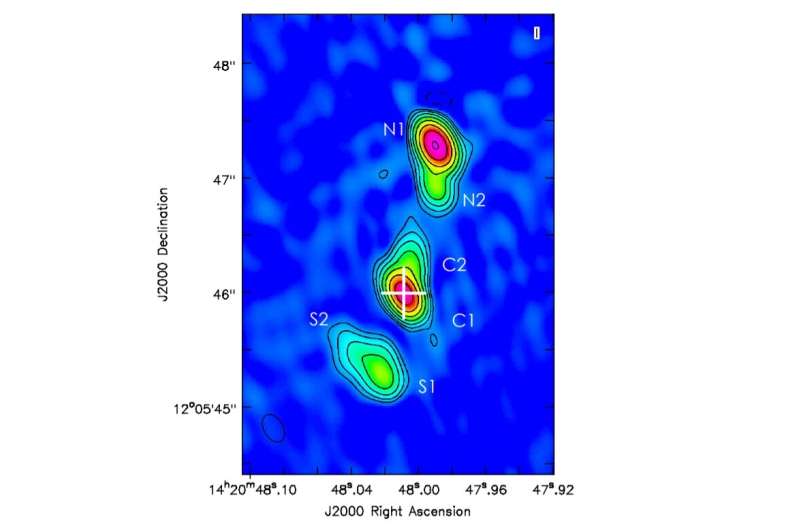October 27, 2021 report
J1420+1205 is a small radio galaxy, study finds

An international team of astronomers has conducted radio observations of an active galactic nucleus (AGN) known as J1420+1205. Results of this observational campaign suggest that this source is not a blazar like was previously thought, but a small radio galaxy. The study was detailed in a paper published October 21 on arXiv.org.
Radio galaxies emit huge amounts of radio waves from their central cores. Black holes at the centers of these galaxies accrete gas and dust, generating high-energy jets visible in radio wavelengths, which accelerate electrically charged particles to high velocities.
During its active stage (lasting even 100 million years) a typical radio galaxy is observed to contain such features like core, lobes, jets and hotspots. However, after this stage passes, these signatures of activity generally disappear as the source's AGN switches off and the galaxy enters the so-called remnant or dying phase.
At a redshift of 4.026, J1420+1205 is a high-redshift AGN classified as a blazar candidate. In general, blazars, classified as members of a larger group of active galaxies that host AGNs, are the most numerous extragalactic gamma-ray sources. Their characteristic features are relativistic jets pointed almost exactly toward the Earth.
Now, new observations performed by a team of astronomers led by Krisztina É. Gabányi of the Eötvös Loránd University in Budapest, Hungary, provide evidence that J1420+1205 is not a blazar but a small radio galaxy. The study was based on data from the enhanced Multi Element Remotely Linked Interferometer Network (e-MERLIN), an array of seven radio telescopes in the UK.
"Our 30 − 100 mas-scale enhanced Multi Element Remotely Linked Interferometer Network (e-MERLIN) radio observations revealed a rich structure reminiscent of a small radio galaxy," the researchers wrote in the paper.
J1420+1205 was observed with e-MERLIN in 2017 at 1.5 GHz and 5 GHz. At 1.5 GHz, three main radio-emitting regions were detected, designated as N, C, and S. At 5 GHz, only the two regions N and C were identified.
The observations allowed the astronomers to calculate the 1.4-GHz radio power of J1420+1205—it was found to be at a level of 9,200 YW/Hz. This, together with the linear extent of J1420+1205 estimated to be some 58,350 light years, suggest that the AGN is a high-power compact steep-spectrum source and can be regarded as a young and small version of a Fanaroff–Riley type 2 radio galaxy.
The radio data also revealed a bright hotspot in J1420+1205. The researchers assume that this hotspot might be related to the denser interstellar medium around a young galaxy at an early cosmological epoch.
Summing up the results, the authors of the paper underlined that their findings indicate a radio galaxy nature of J1420+1205. However, they propose higher resolution observations of this source in order to verify their hypothesis.
More information: Krisztina É. Gabányi et al, A small radio galaxy at z=4.026. arXiv:2110.10964v1 [astro-ph.GA], arxiv.org/abs/2110.10964
© 2021 Science X Network


















